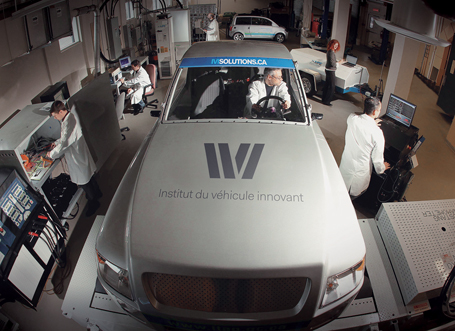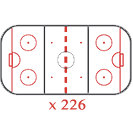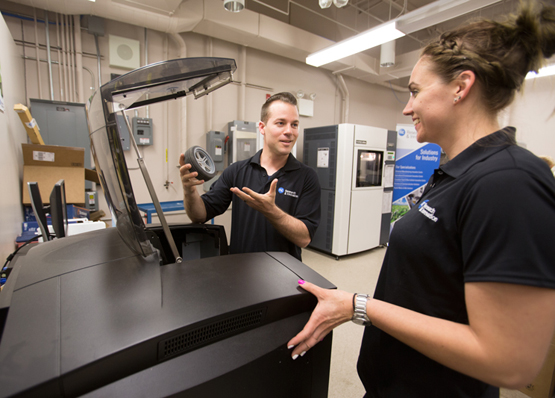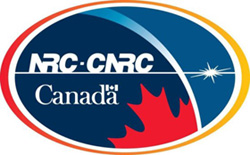About Tech-Access Canada
Tech-Access Canada is a national, not-for-profit organization passionate about expanding the reach of its 64 NSERC-funded Technology Access Centres (TACs) to make their R&D support services accessible to all entrepreneurs and innovators across Canada and contributing to the development of a more inclusive innovation economy.

Our TAC members are the foremost leaders in college applied research and assisting Canadian entrepreneurs in developing new innovative products and solutions using technology.
Collectively, the TAC network provides Canadian firms with access to:

Almost 4 million square feet of dedicated
innovation and applied research space

$477 million worth of state-of-the-art
equipment and research facilities

Over 2,000 experts in business innovation and applied R&D with in-depth industry experience
Vision
Make the innovation and R&D solutions of our member TACs accessible to all Canadian entrepreneurs and businesses to foster inclusive innovation and national economic growth.
Mission
Lead applied research professionals at Technology Access Centres (TACs) to achieve excellence in developing innovative solutions for businesses across Canada.

What We Do
Tech-Access Canada supports the growth, competitiveness, and success of its members by:
- Facilitating the sharing of best practices to help TAC members achieve operational excellence.
- Connecting innovators and entrepreneurs to the TAC(s) within the network with the expertise to advance the development and commercialization of their product or solve their innovation challenge.
- Championing the TACs as major players in Canada’s innovation ecosystem and excellent incubators for top talent and future serial innovators.
- Advocating to senior government officials and heads of agencies on priorities to advance the applied research efforts of the membership and ensure all Canadian innovators can access their R&D services.
- Fostering collaborative partnerships with industry, government, universities, associations, and other innovation stakeholders to advance applied research in Canada.
- Delivering programs that provide opportunities for TAC members to engage in R&D projects with industry partners.
Values
- Excellence: We seek to establish a culture of continuous improvement and exceptional execution to achieve organizational excellence.
- Collaboration: We are stronger together. We collaborate with our TAC members and partners to advance the growth and success of our network, as well as positive innovation outcomes for SMEs across Canada.
- Innovation and Creativity: We embrace creativity and innovative thinking to discover new solutions and fuel the success of our organization.
- Entrepreneurial Spirit: We have a true passion to build, improve, take calculated risks, and execute to achieve greatness.
- Equity, Inclusiveness and Diversity: We value uniqueness and harness diversity to drive organizational innovation. We respect and support our employees to be their true selves, so they thrive as individuals and we succeed together as a team.
About the TACs
A Technology Access Centre (TAC) is a state-of-the-art applied research and innovation centre, affiliated with a Canadian college or cégep, that provides companies with access to cutting-edge technology and equipment, as well as a multi-disciplinary team with the expertise to turn brilliant ideas into market-ready products.
TACs offer value-added R&D and innovation services to Canadian businesses—particularly small and medium-sized enterprises (SMEs)—to develop new prototypes, scale-up processes and solve unique business challenges. They also provide customized training for industry to upgrade technical skills, and de-risk the financial investment of implementing new equipment and adopting emerging technologies. They aim to generate innovation and productivity results, while enhancing the competitiveness of their industry partners.
In addition, TACs positively impact the future of education at colleges and cégeps. They provide outstanding experiential learning opportunities for students from their host institutions and recent graduates from universities, by training them on the latest technologies and equipment, providing engaging work opportunities on applied research projects with industry partners, and guiding them to support businesses undertaking innovation and R&D activities in Canada.
Companies that work with the TACs benefit from flexible intellectual property (IP) policies, and have the right to commercialize the research results and IP. TACs also help de-risk the financial investment required when taking on applied research projects by helping businesses to access and leverage government funding programs.
All TACs within the network have won NSERC-designated Technology Access Centre Grants and receive annual funding from NSERC.
Tech-Access Canada gratefully acknowledges the ongoing support of the Natural Sciences and Engineering Research Council (NSERC) and the National Research Council’s Industries Research Assistance Programs (IRAP) towards this initiative.

How it all started
1983
The Technology Access Centre model is largely based on the very successful Québec centres collégiaux de transfert de technologie (CCTT) model created in 1983. Under the CCTT, the Government of Québec provides stable, predictable funding to maintain and expand the applied research capacity that a college has built in a specific discipline of economic significance in a defined geographic region. Discussions about specialized centres focused on applied research and connected to cégeps began in 1978, and the first CCTTs started in 1983. There are now 59 CCTTs throughout Québec, with no overlap in research areas.
1998
In June 1998, the Canada Foundation for Innovation (CFI) announced the establishment of a $10 million fund designed to help Canadian colleges, institutes and affiliated research centres develop and strengthen their research infrastructure. The College Research Development Fund, approved by CFI’s Board of Directors, was established following extensive consultation with the Association of Canadian Community Colleges (ACCC). Under this new funding mechanism, it was possible for colleges to submit proposals for projects totalling less than $2 million in eligible costs – with a maximum contribution of $800,000 from the CFI. The deadline for the first cohort of proposals was March 1, 1999.
1999
In June 1999 CFI’s Board of Directors approved projects in 15 institutions totalling $7 million under the College Research Development Fund.
2000
In July 2000, CFI’s Board of Directors approved additional projects in 15 institutions totalling $8.5 million under the College Research Development Fund.
2001
The College Research Development Fund (along with a fund for small universities) was wound down and eligible institutions then submitted proposals to the Innovation Fund, by far CFI’s largest program. Of the subsequent $6 billion of CFI funding awarded to 11,000 projects, a total of 15 colleges and cégeps were successful, winning $13 million in non college-specific programming.
2002
Intrigued by the success of CFI’s college-specific program to grow research infrastructure, in the fall of 2002, Senior Management from the Natural Sciences and Engineering Research Council (NSERC) visited 19 community colleges across the country to learn more about the form, nature, and scope of applied research that is being carried out in Canadian colleges. NSERC concluded that the colleges have a significant role to play in building the innovative capacities of communities by helping firms commercialize new discoveries and adopt new technologies. This led to the development of the College and Community Innovation Pilot program.
2003
The College and Community Innovation Pilot program was one of three pilot programs established as result of commitments stemming from NSERC’s Vision, which was approved by Council in October 2003. The rationale for this pilot program was that, while Canada is a world leader in the provision of public funding for research and development (R&D), Canadian businesses and especially small and medium enterprises (SMEs) generally do not invest a significant part of their budget in R&D compared to other Organization for Economic Cooperation and Development (OECD) countries. Colleges were deemed to be well positioned to foster SMEs’ R&D investments.
2004
In 2004, the College and Community Innovation Pilot program – exclusively for colleges – opened a call for proposals. The Pilot program awarded six grants on a competitive basis. A base grant of $100,000 a year for three years was made to successful applicants; funding for years two and three was contingent on successful progress in achieving the goals outlined in the proposal. A mid-term review of the CCI Pilot Program was conducted in 2007.
2007
On March 19, 2007 the federal budget announced that the CCI pilot was made permanent and expanded to additional colleges across the country. Budget 2007 provided $48 million over 5 years to launch the next round of projects. When fully in place, CCIP was designed to support up to 25 college-industry partnerships.
2008
The permanent College and Community Innovation (CCI) program was officially launched in 2008-09 following the Government of Canada (GOC) announcement in Budget 2007, and in the Federal S&T strategy. The program initially only offered the five-year non-renewable Innovation Enhancement (IE) Grant to help colleges build applied research capacity in a specific area.
2010
With NSERC providing project funding, CFI launched the College-Industry Innovation Fund to enhance the capacity of colleges to support business innovation in Canada by providing them with state-of-the-art, industry-relevant research infrastructure to foster partnerships with the private sector in a specific area of strategic priority to the institution.
Budget 2010 provided $15 million in additional funding to support partnerships between colleges and businesses through the CCI program. This allowed for the launch of the project-specific Applied Research and Development (ARD) grants; the Applied Research Tools and Instruments (ARTI) grants; and the pilot of the Technology Access Center grants.
NSERC launched the pilot of the Technology Access Centre funding program to enhance the R&D activities of established college applied research centres, better supporting the growth of regional firms and industry sectors across the country. The goal was to make companies more productive and innovative by providing access to specialized expertise, technology and equipment at nationally-recognized Canadian colleges and cégeps.
2011
Budget 2011 announced additional funding for NSERC CCI, allowing the launch the College-University Idea-2-Innovation grant, as well as 25 Industrial Research Chairs for Colleges.
2012
The first cohort of nationally recognized TAC designations were awarded to nine college and cégep applied research centres:
- Camosun Technology Access Centre (CTAC) (formerly CamosunTech), Camosun College, Victoria, BC
- Transbiotech, Cégep de Lévis-Lauzon, Lévis, QC
- Centre d’expertise et de transfert en agriculture biologique (CETAB+), Cégep de Victoriaville, Victoriaville, QC
- Agrinova, Collège d’Alma, Alma, QC
- Centre technologique en aérospatiale (CTA), Collège Edouard-Montpetit, Saint-Hubert, QC
- Food Innovation and Research Studio (FIRSt), George Brown College, Toronto, ON
- Canada’s Smartest Kitchen (CSK), Holland College, Charlottetown, PEI
- Centre for Sensors and Systems Integration (CSSI) (formerly Nanotechnology Centre for Applied Research, Industry and Training Services), NAIT, Edmonton, AB
- Technology Access Centre for Aerospace & Manufacturing (TACAM), Red River College, Winnipeg, MB
NSERC launches second TAC competition.
2013
The second cohort of TAC designations were awarded to six college and cégep applied research centres:
- Centre de développement et de recherche en imagerie numérique (CDRIN), Cégep de Matane, Matane, QC
- Kemitek (formerly OLEOTEK), Cégep de Thetford, Thetford Mines, QC
- Centre de métallurgie du Québec (CMQ), Cégep de Trois-Rivières, Trois-Rivières, QC
- National Bee Diagnostic Centre (NBDC), Northwestern Polytechnic (formerly Grande Prairie Regional College), Grande Prairie, AB
- Lambton Manufacturing Innovation Centre (LMIC), Lambton College, Sarnia, ON
- Screen Industries Research and Training Centre (SIRT), Sheridan College, Toronto, ON
The TACs began organizing regular meetings through the informal TACCAT Network to share best practices in business operations and recognized they faced common challenges in driving industry innovation, which could have been better supported by harmonious and standardized approaches to college applied research and the TAC model.
NSERC launches third TAC competition.
2014
The third cohort of TAC designations were awarded to six college and cégep applied research centres:
- Institut du véhicule innovant (IVI), Cégep de Saint-Jérome, Saint-Jérome, QC
- Institut des communications graphiques et de l’imprimabilité (ICI), Collège Ahuntsic, Montréal QC
- Centre National en Électrochimie et en Technologies Environnementales (CNETE), Collège de Shawinigan, Shawinigan, QC
- Centre for Advancement of Water & Wastewater Technologies (CAWT), Fleming College, Lindsay, ON
- Walker Advanced Manufacturing Innovation Centre (formerly Niagara College Advanced Manufacturing Innovation Centre), Niagara College, Welland, ON
- SAIT Green Building Technologies (GBT), SAIT, Calgary, AB
NSERC launches fourth TAC competition.
2015
Red River College hosts TAC Best Practices Forum.
The fourth cohort of TAC designations were awarded to four college and cégep applied research centres:
- Innofibre, Cégep de Trois-Rivières, Trois-Rivières QC
- Wearable, Interactive, and Mobile Technologies Access Centre in Healthcare (WIMTACH), Centennial College, Scarborough ON
- Centre d’accès à la technologie en bio-innovation (CAT-B), La Cité, Ottawa ON
- Building Efficiency Technology Access Centre (BETAC) (formerly Centre for Building Envelope Performance), Red River College, Winnipeg MB
NSERC fifth sixth TAC competition.
In November, Niagara College in Niagara-on-the-Lake, ON hosts the Niagara Summit, bringing together all of the TACs to share best practices.
The TACs decide to formalize their TACCAT network to more efficiently and effectively develop standards of practice on which present and future TACs could usefully base their practice, such that industry across the country could expect common, and high-quality experiences across the varying institutions and sectors served by the TACs. In November 2015 at Niagara College the Terms of Reference for the Technology Access Centres/Centres d’accès à la technologie (TACCAT) Network are adopted. Financial and in-kind support for the network was provided by NSERC, the member TACs, and Colleges and Institutes Canada.
2016
- In February, the TACCAT Network hires the inaugural Executive Director to implement the network’s workplan.
- TACAM hosts the Spring Best Practices Workshop in Winnipeg, MB.
- The fifth cohort of TAC designations were awarded to five college and cégep applied research centres:
- Mérinov, Cégep de la Gaspésie et des Îles, Gaspé, QC
- Centre de géomatique du Québec (CGQ), Cégep de Chicoutimi, Chicoutimi, QC
- Technology Access Centre for Livestock Production (TACLP), Olds College, Olds, AB
- Food and Beverage Innovation Centre (FBIC) (formerly Canadian Food & Wine Institute Innovation Centre (CFWI IC)), Niagara College, Niagara-on-the-Lake, ON
- mHealth & eHealth Development and Innovation Centre (MEDIC), Mohawk College, Hamilton, ON
- In June, at the member’s Best Practices Workshop hosted by TransBIOTech in Lévis, QC, the formal network launches publicly and unveils its new website, branding, and name: Tech-Access Canada | Tech-Accès Canada.
- In November, the pilot for the Interactive Visits for SMEs program launches in Ontario with support from NRC-IRAP.
- SIRT hosts the Fall Best Practices Workshop in Toronto, ON.
2017
- Centre d’accès à la technologie en bio-innovation (CAT-B) hosts the Fall Best Practices Workshop in Ottawa
- Tech-Access Canada launches the Jump Ball Initiative to connect any innovator or entrepreneur in Canada with an innovation challenge, to the TACs ready, willing, and able to assist.
- The Interactive Visits pilot program continues to grow and gain interest from clients outside of Ontario.
- Tech-Access Canada represents the TACs by presenting at the Gender Summit 11 North America (GS11NA) conference in Montreal.
- ICI hosts the Fall Best Practices Workshop in Montreal QC
- The TACPITS Portal – Tech-Access Canada’s secure online project management portal was launched to assist the Tech-Access Canada team and member TACs with Interactive Visit project tracking and administration.
- Tech-Access Canada represents the TACs and the Government of Canada by presenting at Intellectual Property Statistics for Decision Makers (IPSDM) conference in Mexico City. The event was co-organized by the Canadian Intellectual Property Office (CIPO), the Mexican Institute of Industrial Property (IMPI), the United States Patent and Trademark Office (USPTO) and the Organization for Economic Co-operation and Development (OECD).
2018
- Canada’s Smartest Kitchen hosts the Spring Best Practices Workshop in Charlottetown, PEI.
- Budget 2018 provides $140 million over five years, to increase support for collaborative innovation projects through the College and Community Innovation Program. Impact of Canada’s TACs as key innovation intermediaries highlighted in budget text.
- New funding allows NSERC to launch the sixth TAC competition, the first new TAC competition since 2015.
- Tech-Access Canada delivers TAC to the Future workshop in Winnipeg inviting representatives from member TACs to present operational best practices to an audience of college and cégep attendees interested in applying for the TAC grant.
- Tech-Access Canada registers as a federal not-for-profit corporation based in Ottawa.
- Expansion of Interactive Visits program to TACs in Atlantic, Prairies and Pacific regions.
- Technology Access Centre for Livestock Production hosts the Fall Best Practices Workshop in Olds, Alberta.
- All TACs from the first cohort are renewed successfully with a second five-year mandate.
2019
- NSERC launches seventh TAC competition.
- Tech-Access Canada delivers in-person TAC to the Future workshop in Niagara for representatives from colleges interested in applying for a TAC, as well as a virtual workshop for cégeps and CCTTs in Quebec.
- CMQ and Innofibre co-host the Spring Best Practices Workshop in Trois-Rivieres, QC.
- OECD TIP Knowledge Transfer and Policies project publishes case study on the successful Technology Access Centre model, unique in Canada and to the OCED.
- Tech-Access Canada represents the TACs by presenting at the Conference of Montreal presented by the International Economic Forum of the Americas.
- Expansion of Interactive Visits program to TACs in all regions of Canada.
- The sixth cohort of TAC designations are awarded to seventeen college and cégep applied research centres:
- Innovate Centre for Arts, Crafts and Technology (INNOVATE) (formerly Arts, Crafts & Technology Micro-manufacturing Centre), Aurora College, Inuvik, NWT
- The BC Beverage Technology Access Centre, Okanagan College, Kelowna, BC
- Boreal Forest Plant & Seed Technology Access Centre, NAIT, Peace River, AB
- Prairie Research Kitchen, Red River College, Winnipeg, MB
- Bio-Industrial Process Research Centre (BPRC), Lambton College, Sarnia, ON
- Cambrian College Centre for Smart Mining, Cambrian College, Sudbury, ON
- Applied Research Centre for Natural Products and Medical Cannabis, Loyalist College, Belleville, ON
- Vestechpro, Cégep Marie-Victorin, Montreal, QC
- Centre collégial de transfert de technologie en télécommunications (C2T3), Cégep de Trois-Rivières, Trois-Rivières, QC
- Centre en imagerie numérique et en médias interactifs (CIMMI), Cégep de Sainte-Foy, Québec City, QC
- Centre d’Accès en Technologies des Énergies Renouvables et du Rendement Enérgetique (TERRE), Cégep de Jonquière, Jonquière, QC
- Living Lab en innovation ouverte (LLio), Le Cégep de Rivière-du-Loup, Rivière-du-Loup, QC
- Innovation maritime – Institut Maritime du Québec, Cégep de Rimouski, Rimouski, QC
- Service de recherche et d’expertise en transformation des produits forestiers – SEREX, Cégep de Rimouski, Rimouski, QC
- Réseau INNOV, Collège communautaire du Nouveau-Brunswick (CCNB), Bathurst, NB
- Nergica, Cégep de Gaspésie et des Îles, Gaspé, QC
- SEATAC, Nova Scotia Community College, Dartmouth, NS
- All TACs from the second cohort are renewed successfully with a second five-year mandate.
- Tech-Access Canada becomes a signatory to the Dimensions charter, committing to encourage greater equity, diversity and inclusion.
- Centre d’accès à la technologie en bio-innovation (CAT-B) hosts the Fall Best Practices Workshop in Ottawa
2020
- The Interactive Visits program is once again open to TACs and SMEs in all regions of the country, that largest program ever.
- The seventh cohort of TAC designations were awarded to thirteen college and cégep applied research centres:
- Agrinova – Biochar, Collège d’Alma, Alma, QC
- Centre de développement des composites du Québec (CDCQ), Cégep de Saint-Jérôme, Saint-Jérôme, QC
- Centre de recherche appliquée en développement durable des territoires (CIRADD), Cégep de la Gaspésie et des Îles, Gaspé, QC
- Centre de recherche et d’innovation en sécurité civile du Québec (Centre RISC), Campus Notre-Dame-de-Foy, Saint-Augustin-de-Desmaures, QC
- Centre d’enseignement et de recherche en foresterie (CERFO), Cégep de Sainte-Foy, Québec, QC
- Centre for Innovation in Manufacturing – Technology Access Centre (CIM-TAC), Red Deer College, Red Deer, AB
- Smart Manufacturing and Advanced Recycling Technologies (SMART) Centre, Conestoga College, ON
- Coalia (formerly Centre de technologie minérale et de plasturgie), Cégep de Thetford, Thetford Mines, QC
- Digital Integration Centre of Excellence (DICE), Saskatchewan Polytechnic, Saskatoon, SK
- Energy and Power Innovation Centre (EPIC), Mohawk College, Hamilton, ON
- Integrated Agriculture Technology Centre (IATC), Lethbridge College, Lethbridge, AB
- Selkirk Technology Access Centre (STAC), Selkirk College, Castlegar, BC
- Technology Access Centre for Oil Sands Sustainability (TACOSS), NAIT, Edmonton, AB
- All TACs from the third cohort are renewed successfully with a second five-year mandate, bringing the Tech-Access Canada family to a solid 60 nationally recognized Technology Access Centres.
Due to the pandemic, the Best Practices Workshop was offered in a virtual format for the first time ever.
2021
Budget 2021 recognizes the positive impact of the Interactive Visits program and provides two years of enhanced funding support, as well as policy direction to enhance the eligibility criteria to encourage the participation of innovative firms owned by members of underrepresented groups.
Budget 2021 also provides the College and Community Innovation Program with two years of additional funding to foster additional collaborative R&D relationships between colleges and companies.
eCampusOntario and Tech-Access Canada enter into a strategic partnership to develop a collaborative innovation platform, and pilot two applied R&D programs.
For the second year in a row, the Best Practices Workshop was offered in a virtual format. A record number of attendees for a Tech-Access Canada event.
2022
The second year of the enhanced Interactive Visits program allowed for multi-TAC Interactive Visits in service of NRC IRAP clients, as well as enhanced eligibility criteria to support a wider groups of Canadian companies. A record number of companies were served and a record amount of funding was fully allocated in early February 2023, and by the end of the fiscal year, over 120 companies were on the waitlist to participate.
NSERC launches the first new TAC competition in three years.
The first in-person Best Practices Workshop in Edmonton Alberta: the TAC Innovate Forum, hosted by the Centre for Sensors and Systems Integration, Technology Access Centre for Oil Sands Sustainability, and the Boreal Forest Plant & Seed Technology Access Centre. Event set a new in-person attendance record for the network, and forged deeper connections within the wider college community.
Tech-Access Canada releases its first report: Technology Access Centres: A Decade of Success!
2023
Budget 2023 provides $108.6 million over three years to the College and Community Innovation Program which will significantly improve capacity at the TACs to service additional companies, as well as provide additional experiential learning opportunities for students.
The Atlantic Canada Opportunities Agency provides Tech-Access Canada with support to pilot the Boomerang-o-vation innovation internship program for college graduates in the Atlantic provinces. The program launches for its first intake in July.
Tech-Access Canada releases its second report: The Future Of Canadian TACs: Thriving in a Rapidly Changing Global Economy
The Interactive Visits program re-launches in May and this year’s program adds 55-hour Strategic Interactions with two TACs to complement the traditional 20-hour Interactive Visits. Demand in the first month of the program increases almost 200% compared to the previous year.
NSERC launches a new TAC competition.
TAC Innovate Forum will take place in September and will be hosted by the BC Beverage Technology Access Centre in Penticton BC.



